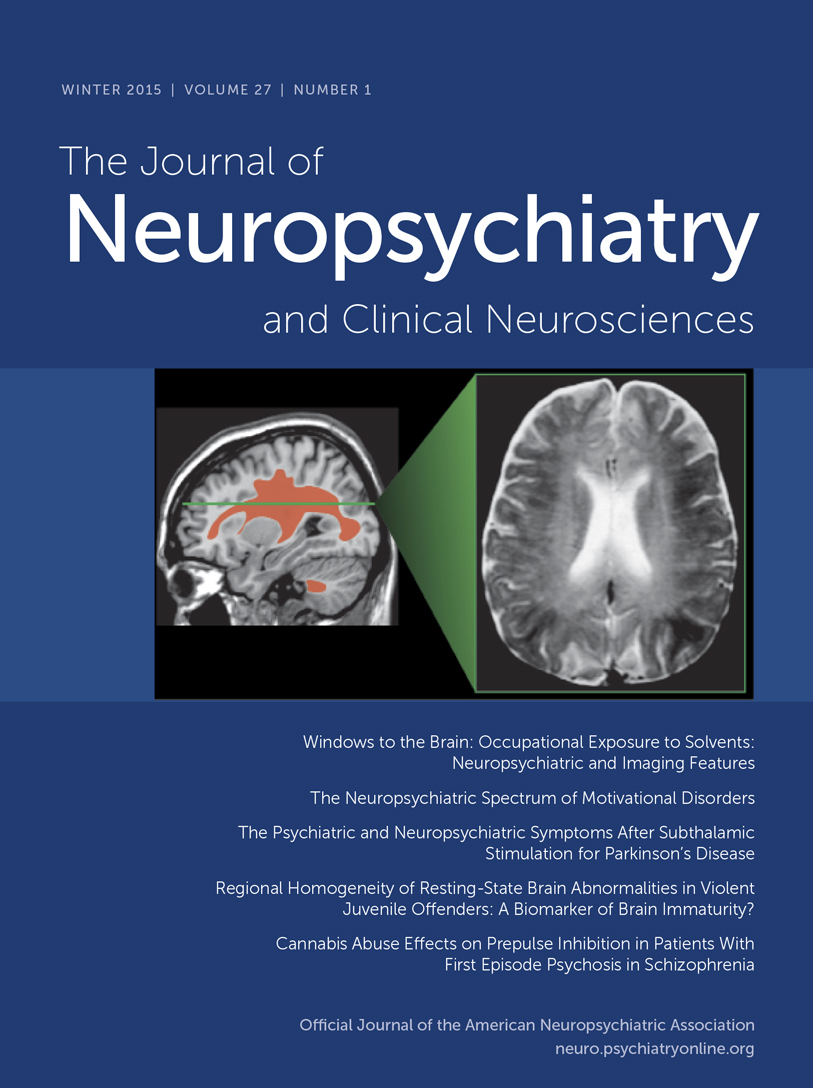Normal Pressure Hydrocephalus Following Ekbom Syndrome
To the Editor: Normal pressure hydrocephalus (Hakim-Adams syndrome)1 and delusional infestation (Ekbom syndrome)2 are two rare conditions, apparently unrelated. We present the first case of coexistence of these two challenging neuropsychiatric disorders.
Case Report
A 65-year-old woman with a history of partial temporal seizures (with olfactory symptoms) and depressive symptoms (reactive to loss of siblings) since age 50 was seen in an outpatient psychiatric consultation setting for delusional infestation with visual and dermatozoic hallucinations. These symptoms, accompanied by weight loss, had developed over the last 2 months, starting right after a flea plague in a rural area. The patient developed skin erosions due to continuous itching and scratching and sought out various dermatologists. A diagnosis of pediculosis, scabies, and dermatitis were all considered, without clinical response to topical permethrin, dimeticone, benzyl benzoate, or betametazone or oral levocetirizine and hydroxizine. She had been on valproate 500 mg and sertraline 100 mg, both once daily, with no epileptic or mood symptom relapse for approximately 14 years. Besides known type 2 diabetes mellitus and dyslipidemia, no changes were found on examination (including brain CT scan) or after reviewing the family history. She was diagnosed with a somatic delusional disorder and medicated with risperidone 1 mg twice per day, with full remission of psychotic symptoms and weight recovery in 2 months. Follow-up showed no clinical changes for 3 years, when at the age of 69 she developed incipient memory impairment, incapacitating ataxic gait, and bladder incontinence. She was referred for neurologic assessment, and 9 months later, a supratentorial ventricular dilation was found on a CT scan. She was referred to neurosurgery with the diagnosis of normal pressure hydrocephalus. Four years after the first evaluation, the patient continues to deteriorate but no further study was made because patient and spouse refused invasive interventions, such as a cerebrospinal fluid flow study, MRI scan, lumbar puncture, or ventriculoperitoneal shunt.
Discussion
Hakim-Adams syndrome was the first treatable cause of dementia ever described but is a difficult diagnosis, with a majority of cases remaining untreated.3 Ekbom syndrome is a neglected condition that, undetected, may lead patients and family to tragic consequences.4 This case report of both conditions in the same individual favors the “two-factor theory,” where dysfunctional cortical processing (parietal cortex) relates to disrupted belief evaluation (frontal cortex), contributing to a possible better understanding of delusional infestation physiopathology.5
1 : The special clinical problem of symptomatic hydrocephalus with normal cerebrospinal fluid pressure. Observations on cerebrospinal fluid hydrodynamics. J Neurol Sci 1965; 2:307–327Crossref, Medline, Google Scholar
2 : Praeseniler Dermat-zooenwahn. Acta Psychiatr Scand Neurol 1938; 13:227–259Crossref, Google Scholar
3 : The differential diagnosis and treatment of normal-pressure hydrocephalus. Dtsch Arztebl Int 2012; 109:15–25, quiz 26Medline, Google Scholar
4 : Ekbom syndrome: a delusional condition of “bugs in the skin”. Curr Psychiatry Rep 2011; 13:178–186Crossref, Medline, Google Scholar
5 : Delusional infestation. Clin Microbiol Rev 2009; 22:690–732Crossref, Medline, Google Scholar



